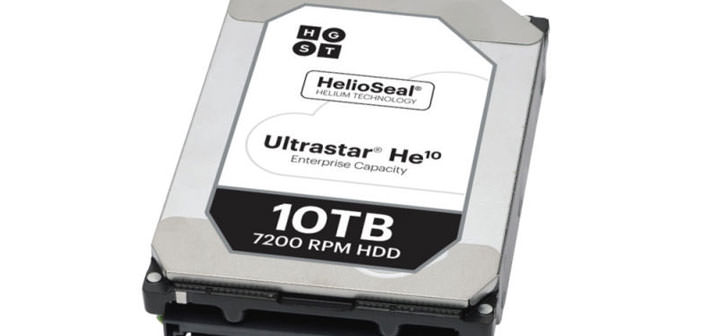The new hard drive of HGST has a maximum capacity of 10 terabytes and is the first to combine this feature with the use of perpendicular magnetic recording technologies.
HGST, a company formed by a joint venture between Western Digital and Hitachi, has announced a new model of family Ultrastar He maximum capacity of 10 TB. HGST Ultrastar HE10 is added to the family was born in 2013 with the model to 6 TB and updated two years later with the release of the 8 TB and 10 TB. The new announced is the second model with capacity from 10 TB, and differs from the previous to the use of a technology of data recording different and more effective in some contexts very precise.
The new Ultrastar HE10 fact is the first to boast a capacity as high and incorporate perpendicular magnetic recording (PMR), the standard used in hard disk drives in recent years. The earlier model issued to August used the magnetic recording layers (SMR), in which the magnetic tracks are superimposed to obtain an increase in capacity of the disc. SMR shows obvious compromises in some areas, such as rewriting of data on disk.
When you have to rewrite the file, a disk that uses technology SMR must rewrite the adjacent tracks, with a clear price to pay in terms of performance. This is why the disks of this type are preferred in those areas where they serve cold storage solutions, and not where it is needed, for example, to rewrite and change often new data. PMR technology used by the new Ultrastar is not perfect, with the most obvious limitations right on the front of the maximum capacity of the disc.
We are coming, in other words, to the physical limit for the possible mechanical disks PMR, although HGST has managed to cram seven courses within a 1-inch hard disk standard, thus creating a unit to be well total 10 TB . This is also due to the fact that in its interior, we do not find common air, but helium. Due to the lower density of the gas, HGST can guarantee an efficiency generally significantly higher than with considerable advantages also on the longevity of the same disc.
The cost of a sealed disk with only helium is substantially higher than disks with the common air, but it is not, if we think with the logic of a large data center in which the disks grind data on 24 hours, seven days a the week. This is because their TCO, the cost in relation to the life of the unit, is a distinct advantage of the discs into helium, mainly thanks to the guaranteed life of about 2.5 million hours. In the future, also, HGST argues that the disks helium will have a production cost identical to that of the traditional models.
HSGT Ultrastar HE10 is guaranteed five years and supports connections SATA 6Gb/s and SAS 12Gb/s. The company claims speeds up to 249MB/s read data, while writing there were about 237MB/s in testing owners. The disc uses a buffer DRAM 256MB and uses 4KB sectors with the ability to emulate sectors by 512 bytes. The company did not declare the list price of the product, even if, according to ArsTechnica, would be around $ 800.

